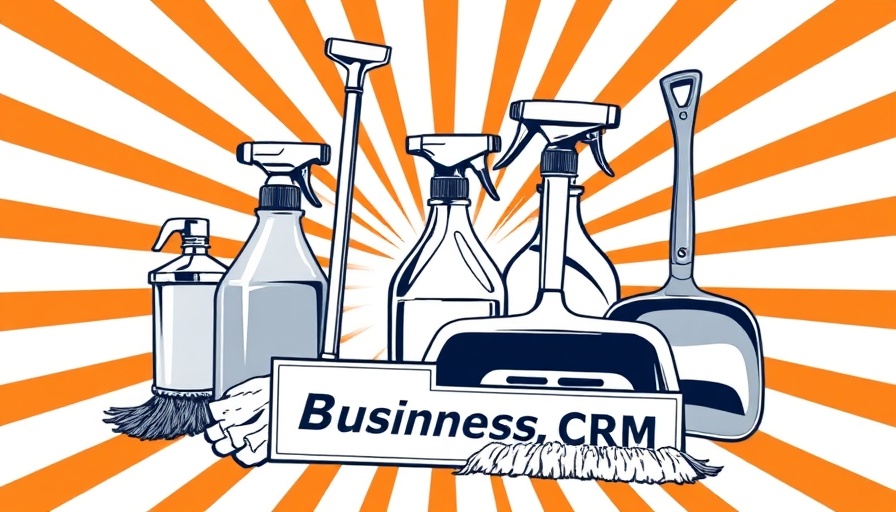
The Importance of CRMs for Cleaning Businesses in 2025
As the landscape of business management evolves, cleaning companies need to adapt to an increasingly digital world. In 2025, maintaining a cleaned space efficiently isn't just about utilizing skilled labor; it involves leveraging technology through Customer Relationship Management (CRM) systems tailored for the unique challenges of the cleaning industry. These systems can revolutionize how cleaning businesses operate, providing streamlined customer interactions and enhancing overall operational efficiency.
Understanding CRM: A Vital Tool for Cleaning Services
A CRM specially designed for cleaning businesses goes beyond standard features—it integrates scheduling, customer communication, and service management into one cohesive platform. It allows companies to automate processes that were once manual, such as sending reminders for service dates and maintaining communication with clients even while on the go.
Top CRMs for Cleaning Businesses - A 2025 Insight
With the rise of specialized software, cleaning businesses can now choose from several CRMs that cater specifically to their needs. Here are five standout options for 2025:
- HubSpot: Known for its user-friendly interface, HubSpot offers a free CRM that supports scheduling, invoicing, and customer service functions, making it ideal for small businesses.
- Jobber: With features focused on scheduling and invoicing, Jobber allows cleaning businesses to efficiently manage teams and client relationships.
- Freshworks: This CRM provides a comprehensive suite for customer management with added tools for tracking support tickets and service interactions.
- Zoho: Offers customizable solutions and integrates well with third-party applications, making it a flexible option for growing businesses.
- ServiceTitan: Tailored for field service businesses, ServiceTitan provides powerful resources for managing on-site jobs and client communications.
The Functional Benefits of an Industry-Specific CRM
Implementing a suitable CRM system can offer numerous benefits such as:
- Improved Customer Relationships: Automated communication keeps clients informed and engaged, potentially increasing retention rates.
- Effective Scheduling: Integrated calendars and reminders facilitate a smoother flow of operations for cleaning services.
- Data-Driven Insights: CRMs can aggregate customer data, enabling cleaning businesses to better tailor their services and marketing strategies.
- Increased Revenue Potential: A well-organized system minimizes missed appointments and improves upsell opportunities through efficient CRM usage.
Choosing the Right CRM: Key Features to Consider
When selecting a CRM, cleaning businesses should assess the following features:
- Mobility: Can the CRM be accessed via mobile devices? This is crucial for cleaning teams that need real-time updates.
- Automation Capabilities: Look for CRM solutions that can automate reminders and follow-ups.
- Customization Options: A good CRM should allow businesses to tailor it to their unique services and workflows.
- Integrations: Ensure the CRM can integrate with other tools used within your business, such as invoicing or marketing software.
A Step-by-Step Guide to Implementing Your CRM
Once you've selected a CRM, getting started involves a few strategic steps:
- Define Your Goals: Determine what you want to achieve with the CRM.
- Train Your Team: Provide necessary training to all employees who will use the system.
- Set Up Workflow Processes: Tailor the CRM to fit your specific operational processes.
- Launch and Monitor: Begin using the CRM and continuously monitor its effectiveness, making adjustments as needed.
Final Thoughts on Adopting CRMs in Cleaning Businesses
In today's competitive environment, effectively managing customer relationships is paramount to sustaining a successful cleaning business. Through thorough research and understanding of CRM systems, small business owners can better equip themselves to enhance service delivery and foster stronger customer ties. As technology continues to evolve, forward-thinking cleaning businesses will undoubtedly discover that integrating the right CRM is not just beneficial; it is essential for thriving in 2025 and beyond.
For cleaning business owners, the selection of a CRM can seem daunting, but focusing on specific needs can streamline the process. Explore options, compare features, and take the leap into digital management for a cleaner, more organized future.
 Add Row
Add Row  Add
Add 




Write A Comment